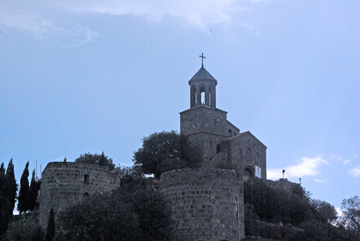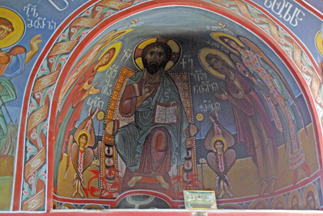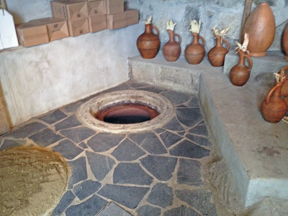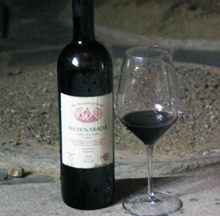Shavnabada Monastery of Saint George
Wine Cellar
by
Terry Sullivan
 Summary: High atop Mount Shavnabada monks make traditional Georgian wine in qvevri following centuries old ways. Visit the monastery and see where the qvevri are buried and taste qvevri wines and Chacha. You can view the city Tbilisi as well as land that goes on for kilometers in every direction.
Summary: High atop Mount Shavnabada monks make traditional Georgian wine in qvevri following centuries old ways. Visit the monastery and see where the qvevri are buried and taste qvevri wines and Chacha. You can view the city Tbilisi as well as land that goes on for kilometers in every direction.
You can see the monastery sitting high on top of Mount Shavnabada, not far from the city of Tbilisi. Father Kalenike, from the monastery, said that monasteries and churches were built in high places in order to help see an invading force and remind people when they look up to the summit of a mountain they should see God. Traveling through Georgia, we have noticed that when people see a church or monastery many will make the sign of the cross.
The original monastery was built in the 12th century and rebuilt in the 17th century. A series of strategically placed churches and monasteries throughout Georgia could light a fire if there was an invasion for an enemy force. In a short period of time, the people living in the country would know of an impending attack.
The church is bright with reproductions of the original frescos that were painted on the walls. Many of the frescos tell stories. A fresco of Saint Nino shows her holding a grapevine cross. Saint Nino brought Christianity to Georgia during the 4th century and she performed several miracles.


The monastery is home for several monks and winemaking. Winemaking is done in earthen vessels, qvevri. In a building next to the monastery, several qvevri were in the ground, most containing wine. In an area close to the monastery, many more qvevri are buried.
 Wine Production
Wine Production
Both white and red grapes are pressed in a wooden press. The juice runs into a qvevri and then the stems, seeds and skins (chacha) is added to the juice in the qvevri. For white wines, the juice ferments on the chacha. After fermentation, the wine remains with its chacha for about six months. After this period of extended maceration, the white wine is racked into a clean qvevri where it will continue to age for a few years. Red wine ferments on its chacha. After fermentation the red wine is racked into a clean qvevri and allowed to age for several years.
The leftover chacha from white wine production is distilled to make a high alcohol grappa-like drink called Chacha. The monastery makes two types of Chacha, one is stored in oak barrels for several years while the other is stored in qvevri for several years.
The wine cellar at Shavnabada Monastery of Saint George produces about 150,000 bottles of wine. Presently it exports to the Ukraine and Italy. There are plans to increase exports to other countries. Some of Europe’s royal families as well as the Patriarch of Georgia receive a bottle of the monastery’s wine as a gift.
 Wines
Wines
We tasted two wines and a Chacha. The 2007 Rkatsiteli was a dark amber color. Floral notes and dried fruit were noticed on the aroma as well as the taste. The wine had tannins and a floral finish. The 2007 Saperavi was a dark ruby color. The aroma had dark fruit notes and an earthiness. The taste was of blackberries. Bold chewy tannins were accompanied by fruit on the finish. The 2009 Chacha was made from Rkatsiteli chacha and aged in oak. It had a dark amber color. Dried fruits and alcohol were noticed on the aroma while the wine was smooth and tasted of dried fruits. The finish had heat and a dried fruit aftertaste.
Father Kalenike would like people to know that the monastery has been making wine for centuries. Wine enthusiasts and travelers can come to the monastery and taste original Georgian wines aged in qvevri for several years.
Shavnabada Monastery of Saint George
Wine Cellar
Tbilisi, Georgia
